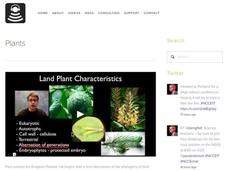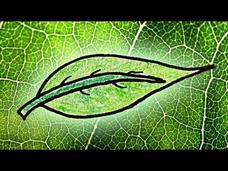Crash Course
The Sex Lives of Nonvascular Plants: Alternation of Generations
Plants evolved more than 400 million years ago into two types — vascular and nonvascular. Here's a video that explains the difference between vascular and nonvascular plants and then focuses on the over 24,000 types of nonvascular...
Bozeman Science
Plants
Use a biology video to focus on four main groups of plants: bryophytes, ferns, gymnosperms, and anglosperms. It explains the parts of plants, life cyles, evolution of plants, and even touches upon sporophyte and gametophyte.
Crash Course
Vascular Plants = Winning!
Viewers explore vascular plants with a video that shows their different tissues, their ability to grow taller and wider, and their parts. Young scientists then see these plants xylem and phloem and learn how vascular plants move...
Crash Course
The Plants and the Bees: Plant Reproduction
This video explains the difference between gametophytes and sporophytes and uses this this information to teach the reproduction process of various vascular plants. Viewers see how ferns, gymnosperms, and angiosperms reproduce.
Be Smart
Do Plants Think?
Plants react to many different stimuli, but do they think? After many years, scientists now have a definite answer. A video shares the theories and facts as part of a larger biology playlist. From plants listening to music to plants...
Be Smart
We've Got Ants in Our Plants!
Some ants are so aggressive, they can repel an elephant. Viewers learn this fact and more in an engaging video that is part of a larger playlist on biology. It discusses the relationships between ants and plants. While plants provide...
FuseSchool
Transport in Plants, Part 1: Xylem and Phloem
Humans use their hearts and circulatory systems to move things through their bodies, but plants also have a transport system. The first video in a three-part series introduces the xylem and phloem. It explains what each part moves, which...
Physics Girl
Why Aren't Plants Black?
In an evolutionary sense, plants seem to have it all figured out. But, do they really? The narrator of an engaging physics video that is part of a larger series questions the predominant color of plants in a short video. Content includes...
MinuteEarth
Why Are Leaves Green? Part 1
Consider a question that baffles even scientists. Why are leaves green? The video lesson offers a theory that begins with the first aquatic plants. Learners consider alternative explanations as well.
Kurzgesagt – In a Nutshell
3 Reasons Why Nuclear Energy Is Awesome!—Part 3
Nuclear energy saves more lives than it harms. A powerful video explains the great things about nuclear energy and why we should increase nuclear power plants. It highlights the benefits for global warming and a new way to make nuclear...
FuseSchool
Transport in Plants, Part 3: Phloem and Translocation
Leaves produce sugars through photosynthesis, but how do the sugars get to the rest of the plant? The final video in a three-part series within the Fuse School Biology playlist answers this question. It details how the phloem and...
MinuteEarth
Why Are Leaves Green? Part 2
Examine the role of chlorophyll in the process of photosynthesis. An interesting video lesson helps learners understand the efficiency of green chlorophyll as it creates energy for a plant. Although 99.9 percent of plants use green...
FuseSchool
Plant Growth: Auxins and Gibberellins
Why does a plant grow toward the sun? The video, part of a Fuse School Plants playlist, explains the chemical processes behind plant growth. It details how auxins, gibberellins, and the sun work together. From curving plant stems to...
FuseSchool
Transport in Plants, Part 2: Xylem and Transpiration
Ninety-nine percent of the water absorbed in plants transpires into the atmosphere. The second video in a three-part series explains transpiration in plants. It details how they pull water into the roots; how water passes through the...
Crash Course
Plant Cells
Why can't plants escape prison? Because their cells were surrounded by walls. Introduce viewers to the evolution of plants with a video that discusses the differences between prokaryotic and eukaryotic cells, plant cells' organelles, and...
SciShow Kids
Like Fruit? Thank a Bee!
Bees play a crucial role in pollination. In fact, without bees, a lot of fruits and vegetables would not exist if it weren't for bees. Watch a video that explains and demonstrates how bees pollinate plants.
Curated OER
Photosynthesis: Light Reactions
This clip picks up right where the Khan Academy's Photosynthesis video left off. Chemicals such as hydrogen and compounds such as NADPH are reviewed along with details including the stroma, thylakoid, lumen, and grana. See the parts of a...
Bozeman Science
Plant Structure
Let's get to the root of biology. A video describes the difference between monocot and dicot plants. Then it explains the three main types of tissues in plants and the cells within each of these tissues.
Bozeman Science
Plant Nutrition and Transport
Discuss what nutrients plants require and where they get them from. An informative video explains the dermal, vascular, and ground tissue in both monocot and dicot roots, as well as stems and leaves.
Be Smart
The Surprising Origin of Thanksgiving Foods
Many of the foods pilgrims ate include foods people still eat at American Thanksgiving celebrations today. The turkey, a domesticated animal native to the Americas, often finds itself the center of attention on this holiday. Today's corn...
Amoeba Sisters
Plant Structure and Adaptations
Non-vascular plants, like moss, are able to survive on photosynthesis. A video explains plant structure for both vascular and non-vascular plants. It includes the parts of each plant and adaptations to various environments such as...
Crash Course Kids
Who Needs Dirt?
How do plants get the nutrients they need? This is the focus of a video that discusses how plants use photosynthesis to survive, with or without dirt.
Crash Course
Photosynthesis
Seventy percent of the world's oxygen is produced through photosynthesis by phytoplankton, microscopic plants found in the ocean. Viewers learn about the complex process of photosynthesis with a video that covers both the light...
FuseSchool
Plant Hormones: Tropisms
Why do stems grow up and roots grow down? A video from the Fuse School Plants playlist explains the four types of tropisms that control plant growth. Simple graphics demonstrate the importance of each type of tropism for various parts of...
Other popular searches
- Identifying Parts of Plants
- Parts of Plants Video
- Parts of Plants Organizer
- Reproductive Parts of Plants
- Parts of Plants Cell
- Comparing Parts of Plants
- Plants Parts
- Parts of Plants Mnemonic
- Edible Parts of Plants
- Comparing Plants Plant Parts
- Plants and Their Parts
- Plants Parts for Food

























